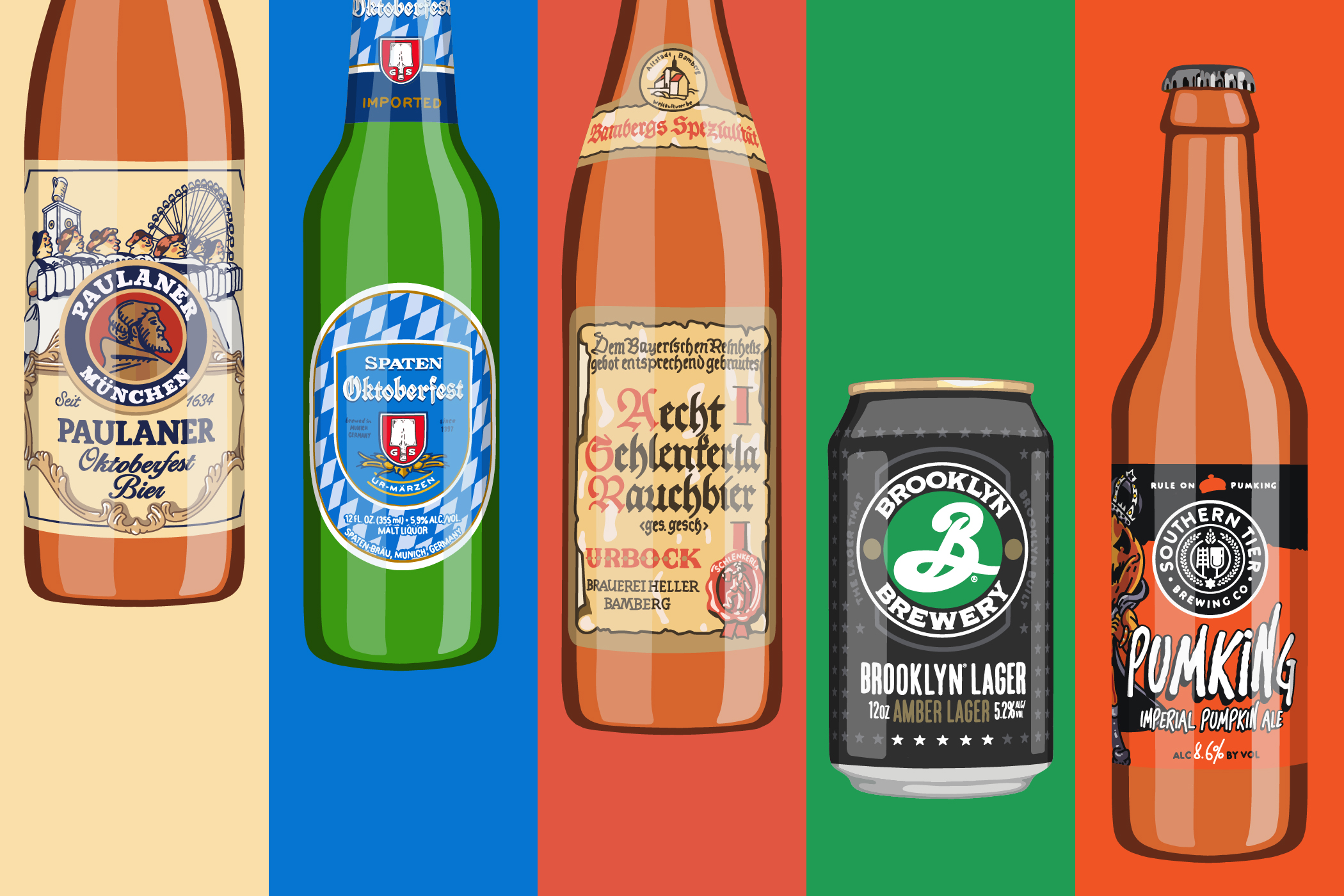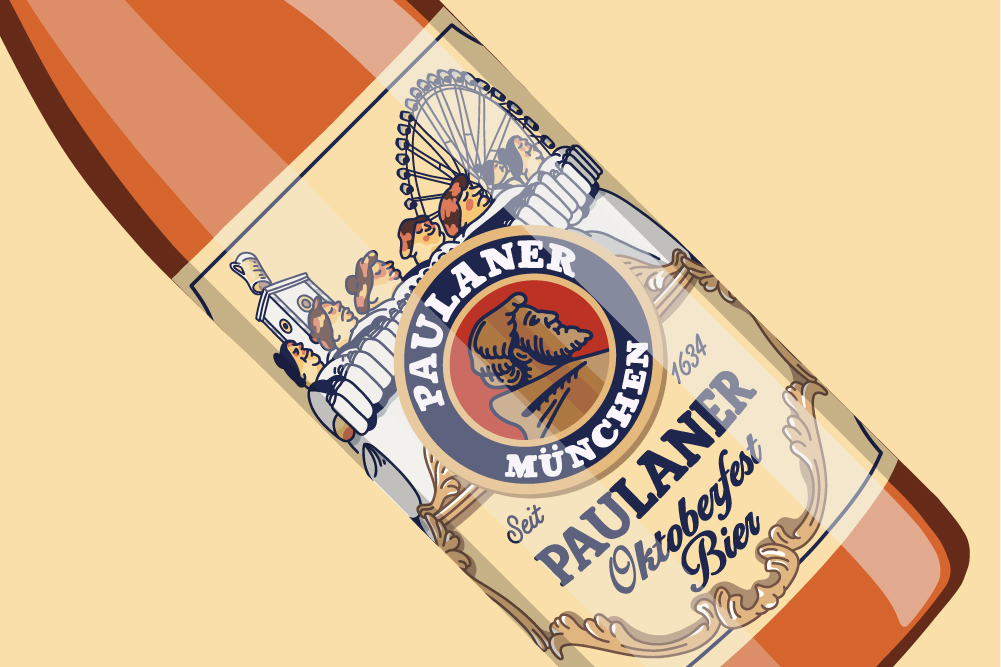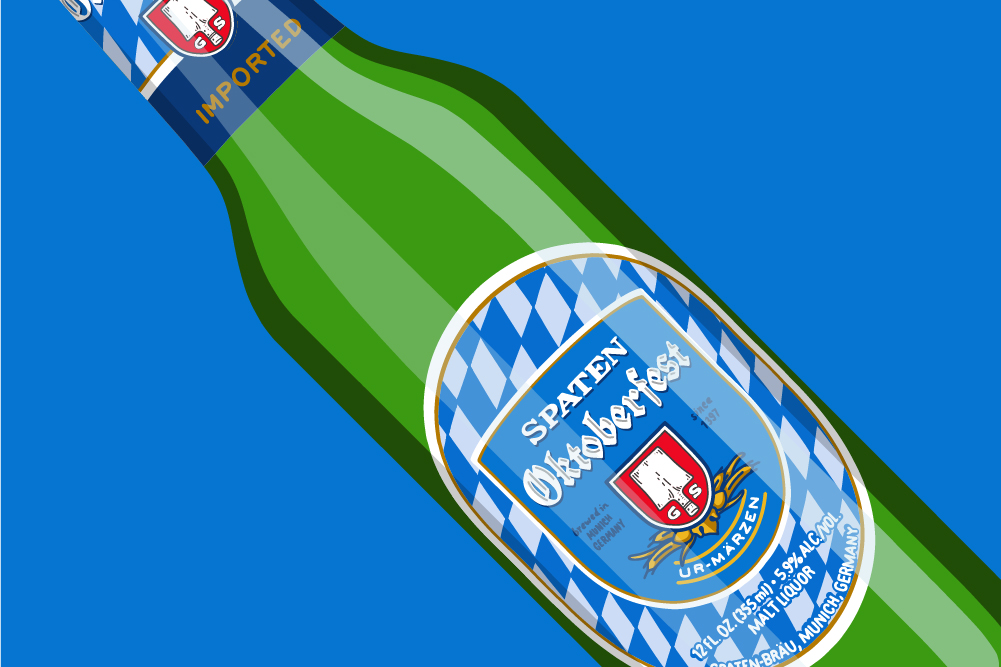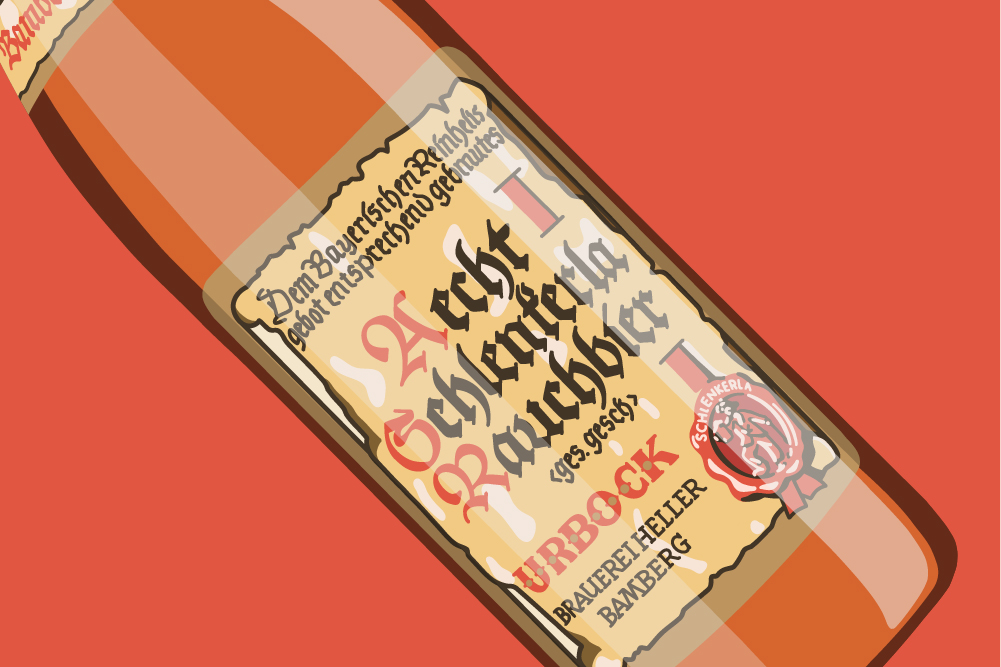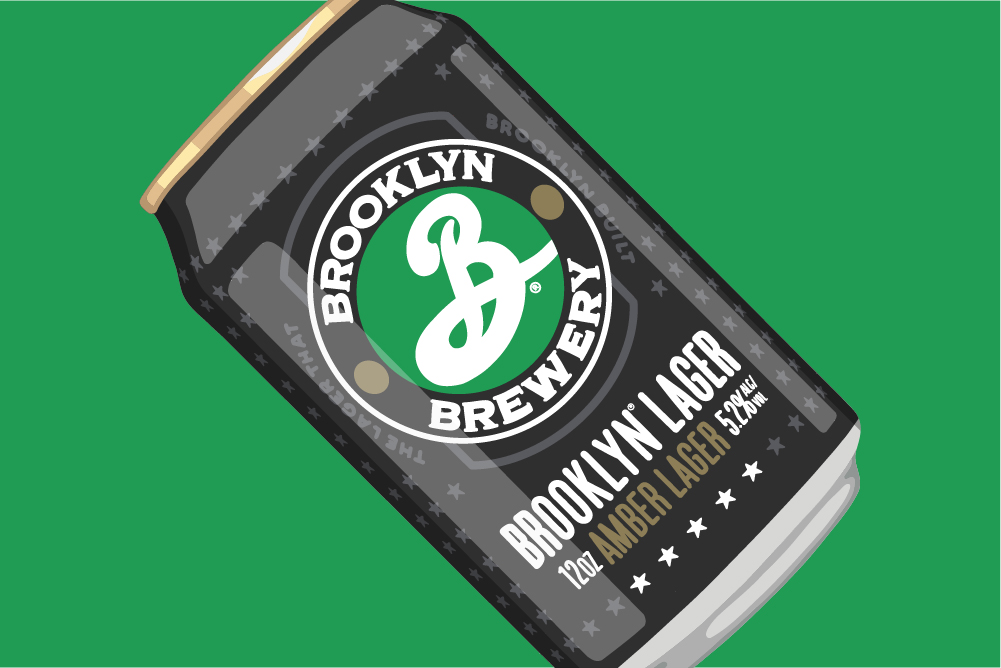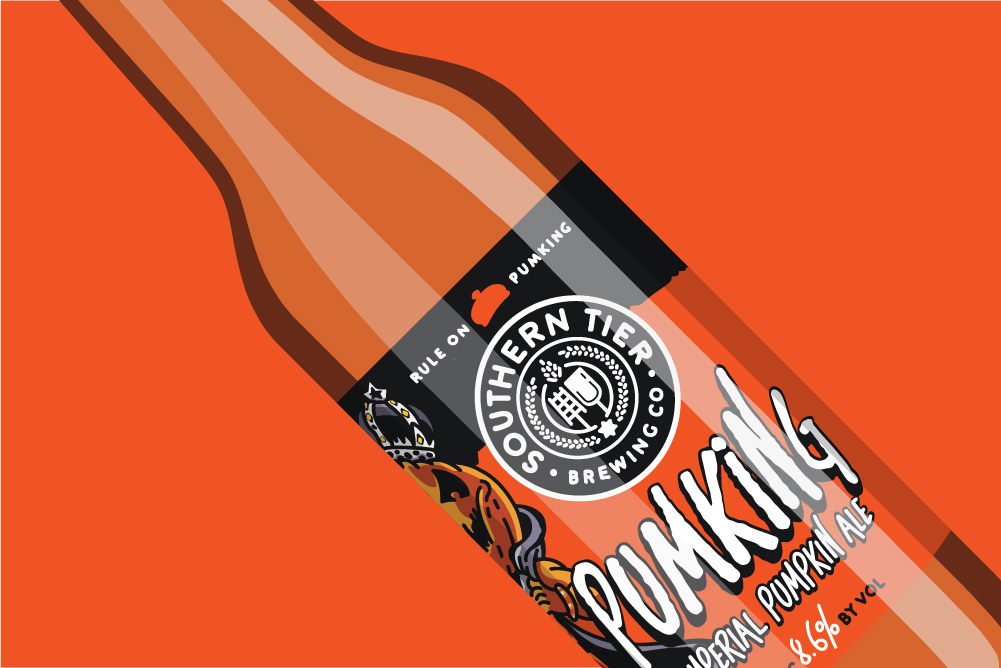Shop
The 30 Most Iconic Beers to Drink in Fall 2024
Check Out Other Iconic Beers:
All hail fall! As I’m sure you know by now, autumn is one of our favorite seasons. To us, this is indisputable. We get goosebumps when fall rolls into town, blowing in its red, orange, and yellow leaves and chilly sweater weather. And nothing beats chilling around the fire with a golden malty yet slightly hoppy beer like a Festbier or a malty German amber lager like a Märzen.
Following our wildly successful “The 27 Most Iconic Beers to Drink in Spring 2024” and “The 29 Most Iconic Beers to Drink in Summer 2024,” we’re putting together our own version for September, October, and November.
Welcome to another installment of our series on The Most Iconic Beers to Drink Each Season. For this content, we’ll write about what we feel are the top five styles that pair best with the time of year, identifying the most iconic (and widely available) beer to drink in that style, along with a few other recommendations.
So, while this list may look a little shorter than similar seasonal pieces from the past, it will also include more beers accessible to a broader audience.
But hey, we’re just giving this a shot. Prefer the past format? Want to see more beers in the future? You can always drop us a line in our DMs or shoot us feedback at [email protected].
Our Most Iconic Beers for the Fall of 2024
Festbier
A strong golden German lager similar to a helles, just maltier, the Festbier has become the official beer of Munich’s annual Oktoberfest.
Historically, the beers served at Oktoberfest can only come from the large breweries inside Munich’s city limits, including Augustinerbräu Münche (Augustiner), Hacker-Pschorr, Hofbräu, Löwenbräu, Paulaner, and Spaten-Franziskaner-Bräu (Spaten).
And the official style has varied over the years.
During the first sixty or so years, the darker Bavarian dunkel dominated. But by 1872, Spaten Brewery introduced the more amber-hued Märzen, which became the official beer of the fest. In the mid-1960s, Paulaner’s golden-colored Oktoberfest Bier, considered a Festbier, began to take over.
Which is why we’re kicking off this list with the OG.
Paulaner Oktoberfest Bier – Paulaner Brauerei
Munich, Bayern, Germany
Festbier – Paulaner has brewed its Oktoberfest Bier since 1818, but it actually didn’t gain popularity at the annual celebration until much later.
“Paulaner brewery is a real traditional Munich brewery and has always played a big part in the history of the city’s culture,” says Christian Dahncke, head brewmaster at Paulaner. “[So Oktoberfest] is an event dear to Paulaner’s heart.”
Today, Paulaner’s Oktoberfest Bier is the most-served beer at Oktoberfest in Munich. Although still slightly malty, the floralness and spiciness of Noble hops are more prevalent in this style. And they’re somewhat meatier at 6-6.5% ABV. Still light in body, Festbiers are super drinkable and perfect for the two-week-long celebration.
Meaning you can seek out and pack them in at your leisure even if you didn’t make it to one of beer’s most famous festivals.
Other Iconic Festbiers to Consider
🍻Hofbräu Oktoberfestbier – A true Festbier, Oktoberfestbier clocks in at 6.3% ABV, making it a bit bigger than its traditional counterparts. Still, this beer is intimately quaffable. Pouring a shiny gold thanks to light barley and Munich malts, Hofbrau’s version feels soft on the palate. The slightly sweet finish gets you ready to go in instantly for another sip. This is the beer you want alongside some of that traditional Oktoberfest roast chicken.
🍻Weihenstephaner Festbier – Although technically not one of the big six Munich breweries, Weihenstephan still makes “a beer that truly represents the Bavarian way of celebrating.” Pouring a deep gold, Weihenstephaner Festbier is a full-bodied, rich seasonal lager that you can only find during Festbier season.
And we’ve got it right here for you.
🍻Human Robot Festbier – One of the “Best Beers We Drank in 2023,” we featured Human Robot’s Festbier in our best-selling Oktoberfest box last year and this year. Our social media manager, Magic Muncie, who got a bunch of these beers sent to him to shoot for the ‘Gram, kindly drove some down to Hop Culture Senior Content Editor Grace Lee-Weitz (he only lives about an hour and a half north of her).
We’re huge Human Robot fans; the brewery is definitely on our must-visit list if we ever make it to Philly one of these days. Instead of traveling coast to coast, getting our hands on Human Robot’s eponymous Festbier was the next best thing.
Look, over the last couple of years, we’ve tasted a lot of Festbiers for this annual piece. Candidly, along with Märzens, it’s one of our favorite fall styles.
Human Robot’s is unparalleled, which is probably why it ranks as Untappd’s fifth highest-rated Festbier of all time!
Human Robot puts its Festbier through an intense process, including a double-decoction mash along with a slow, cold fermentation.
You can taste the dedication. We get a lovely light buttery RITZ Cracker backbone from the German pilsner and Munich malt (plus the decoction step just has this incredible way of smoothly bringing out the rustic edges of malt, if that makes sense). The first sip gives way to a honied sweetness and finally a bite of Herbrucker bitterness.
This beer just has its s**t together but in such a humble way. It’s not outshining anyone, it’s not asking for the spotlight, it’s just quietly, tightly buttoned up to a T. It’s excellent lager craftsmanship at its finest.
🍻Jack’s Abby Copper Legend – When Oktoberfest rolls around each fall, Jack’s Abby Copper Legend becomes a staple in our beer fridge. Mainly because it’s such an excellent expression of the Festbier style. Probably because Jack’s Abby Brewmaster Jack Hendler painstakingly aims for his German beers to match the traditional styles. Smooth, malty, and super quaffable, Copper Legend is a go-to.
🍻Schilling G’suffa! – Landing sixth on Untappd’s All-Time Top-Rated Festbier list, Schilling’s G’Suffa! reminds us of revelry or, as they like to say in Munich, “Oans, zwo, drei, g’suffa!” Schilling’s annual Festbier release just puts a smile on our faces.
Pouring clear-as-a-bell gold, the Festbier includes Weyermann Bohemian Pilsner and Vienna malts for that chewy grain goodness, followed by Bavarian Saphir and Amira from HVG Hops for that light potpourri counterbalance.
The lager-heavy brewery sounds G’Suffa for natural carbonation for a beer that’s equal parts malty, floral, and all good times.
Märzen
As we mentioned, when Spaten brewed the first Märzen in 1872, it became the official beer of Oktoberfest in Munich.
These German amber lagers, typically anywhere from chestnut to russet in color, hit the palate as smooth, toasty, bready, and slightly spiced with a bit of a Noble hop bite.
Märzens clock in around 5-6% ABV with a dry finish.
In America, Märzens are the most common style of what we’ve come to call Oktoberfest or Oktoberfest-style beers.
Spaten Oktoberfest Ur-Märzen – Spaten
Munich, Bayern, Germany
Created in 1872, Spaten Oktoberfest is considered the world’s first Märzen. Towing a lustrous line between amber and gold, this version boasts deep, toasty notes complemented by a crisp citrus lemon bite. Simply put, this version from Spaten is not to be missed. Luckily, it’s pretty readily available here in the U.S. Just be careful not to confuse this Märzen with Spaten’s golden Oktoberfestbier, only available in Germany. The Mayor of Munich kicks off the official Oktoberfest celebration by tapping a keg of Spaten Oktoberfestbier. So, unless you travel to Munich, you won’t be able to try Oktoberfestbier, but Spaten Oktoberfest is an amazing alternative.
Other Iconic Märzens to Consider
🍻Hacker-Pschorr Original Amber Märzen – Brewed in reverence to the Bavarian Purity Law of 1516, known as Reinheitsgebot, the Original Oktoberfest Amber Märzen from Hacker-Pschorr is a perennial favorite. Amber in color and stunningly smooth, this märzen stands for everything the style represents—a perfect marriage of sweetness and maltiness.
🍻3 Floyds Munsterfest – A tribute to German brewing, Munsterfest uses only German malted barley, Bavarian noble hops, and traditional lager yeast. You’d expect 3 Floyds to go a little crazy and over-the-top with their version of a Märzen, but really, everything stays pretty classic here. Well, except for the artwork, which in itself blows our minds. Amber, toasty, and roasty, Munsterfest won’t melt your brain, but it will certainly keep you smiling all through the fall. Which is why we named it one of our “Top 31 Oktoberfest Beers to Try in 2024.”
🍻Bierstadt Lagerhaus Oktoberfest – A beer that garnered a ninety-six from Craft Beer & Brewing and landed third on Untappd’s All-Time Top-Rated Märzens, Oktoberfest from Bierstadt Lagerhaus has a “restrained aroma of light, sweet caramel, and a light zesty quality that emerges as it warms,” writes the panel. Expertly malty with just a bit of Noble hop bite, Bierstadt’s Oktoberfest is the perfect reincarnation of the traditional German style. We wouldn’t expect anything less.
🍻von Trapp Oktoberfest – At this idyllic brewery in Stowe, VT, the hills are always alive with the fresh taste of helles. But, when fall rolls around at the brewery owned by the same family portrayed in The Sound of Music, calls for Oktoberfest can be heard from the peaks’ tippy tops.
Featuring a blend of light and dark Munich malts, von Trapp’s Oktoberfest contrasts that malty almost s’mores-like backbone with the floral, peppery Hallertau and Tettnang hops.
As the brewery writes in the beer’s Untappd description, “Say ‘Prost’ with this crisp and celebratory lager.”
🍻Goldfinger Oktoberfest Ur-Märzen – To make Oktoberfest Ur-Märzen, which ranks in the top ten on the list of Untappd’s All-Time Top-Rated Märzens, Goldfinger stays as faithful to traditional Märzen brewing as possible. Which means that yes, they brew this beer in March, and yes, they tie up one of their lagering tanks to cold condition for six months until September. At this point, Goldfinger’s German lager is nice and ready for Oktoberfest. But this also means that Goldfinger only brews a certain amount, and once it’s gone, it’s gone! Get this one while you can.
Rauchbier or Smoked Beer
All beer was once smoked beer or rauchbier in German. “It’s a lost knowledge that smoke beer was the original way of making beer,” Sixth Generation “Heller-Bräu” Trum, more commonly known as Schlenkerla, Brewmaster Matthias Trum tells us from his childhood bedroom above the historic smoked beer tavern in Bamberg, Germany.
Today, Schlenkerla is known as one of the quintessential smoked beer breweries, continuing an art bred from history but lost to innovation.
Rauchbier, which literally translates to “smoked beer” in German, gets its distinct campfire-like flavor from drying malt in a kiln fueled most commonly by Beechwood.
The polarizing style has a fascinating, if slightly smoky, history, surviving near extinction thanks partly to Schlenkerla in the Bavarian region of Germany.
If you want to read all about it, head here. If you just want to know the best ones to drink, keep reading below…
Aecht Schlenkerla Rauchbier – Märzen – Schlenkerla (“Heller-Bräu” Trum)
Bamberg, Bayern, Germany
One of the most classic interpretations of the style still alive today, Aecht Schlenkerla Rauchbier has to be at the top of your must-try rauchbier list.
This beer has quite a history, surviving near extinction. And when the smoke cleared, this smoked beer made a place for itself in local lore.
“There’s an old Bamberg proverb that when you drink smoked beer … you have to drink three pints to fully appreciate the aroma and flavor,” says Trum, sixth-generation brewer.
Arguably the most classic example of the style, Aecht Schlenkerla Rauchbier is a dark, aromatic, bottom-fermented 5.1% ABV lager—essentially a smoked Märzen—brewed with Original Schlenkerla Smokemalt and tapped according to the old tradition directly from the gravity-fed oakwood cask in the fourteenth-century brewery tavern.
“The classic Märzen smoked beer is made with (basically) 100 percent smoked malt and a tiny bit of roast malt to fill out the color differences between malt batches,” says Trum, “because obviously with an open fire, you cannot adjust the color as exactly as in a modern kiln.”
While brewing, Schlenkerla uses a decoction mash to emphasize the malt’s unique notes. “By boiling the mash, you add additional flavors, and you get a more intense and more bread-like aroma in the beer,” explains Trum.
The classic Märzen smoked beer lagers for two months before it’s ready to drink fresh out of wooden barrels in the tavern, which, if you follow Trum’s advice, is the best place in the world to drink it.
”When you sit on a chair which has been around for 100 years, the table 150 years, and the room around you is 500 years old,” Trum emphasizes, and drink an Aecht Schlenkerla Rauchbier right from the wooden barrel, well, that will never get old.
But we understand drinking straight from the gravity-fed wooden cask at Schlenkerla’s tavern isn’t always possible.
Luckily, you can find this beer distributed pretty widely throughout the United States.
Although maybe consider planning a trip for next year…I know we are. 😉
Other Iconic Rauchbiers or Smoked Beers to Consider
🍻Spezial Rauchbier Lager – Hop Culture Freelancer Ryan Pachmayer, who traveled to the Franconia region, put together this excellent guide for us. In addition to Schlenkerla, he suggests visiting the other historic rauchbier brewery, Spezial.
He writes, “While both have an old-world charm, the beers are remarkably different. Schlenkerla’s beers have a more pronounced, deeper smoke flavor, while Spezial’s beers have an almost delicate smoke flavor.”
🍻Dovetail Rauchbier – Brewed year-round, Dovetail’s Rauchbier is a revelation and probably one of our favorite versions made Stateside.
“For me, it’s a chocolate bar with the smoke in the beer with a sea salt flavor,” explains Dovetail Brewery Brewer and Marketing and Creative Manager Jenny Pfafflin. “It’s savory sweet but not a sweet beer because it has a lot of bread crust.”
Dovetail stays close to Schlenkerla-esque percentages with ninety-five percent Beechwood smoked malt and a little chocolate malt. “People are usually shocked to find that much smoked malt,” says Pfafflin, noting they also double decoct to “throttle up that maltiness, which balances out the smoke.”
While the smoke does dominate, Pfafflin says Dovetail also adds complexity with Tettnang hops.
“We do a coolship addition as well as hot-side hopping, so you’re getting more of an herbally hop character,” she explains. “It’s the herbalism and hoppiness that helps balance the beer, the smoke, and the malt.”
🍻Barrique Brewing & Blending Rauchbier – To make Barrique’s Rauchbier, Barrique’s Head Brewer Spencer Longhurst typically starts with forty-three percent of Weyermann’s smoked Beechwood malt before adding Munich I and Munich II and a tiny bit of chocolate malt just for color adjustment.
“I work everything backward from there,” he shares. Since he tries to keep Barrique’s version style-specific, in this case, a Märzen, Longhurst isn’t looking for a defined hop character.
“Just enough bitterness to balance some of the sweetness and the malt depth,” he explains. Barrique uses German Tradition through two additions. “At first wort and one with thirty minutes remaining in the boil for 18.5 IBUs,” says Longhurst. “Not a great deal of consideration in the hops; it’s just to balance.”
Longhurst then lagers the rauchbier for nine weeks. “It’s about two weeks in the primary fermenter and then about six to seven weeks lagering and packaging,” he says.
The result speaks for itself.
Longhurst describes the beer as pouring a deep, dark amber with an aroma like “a gentle campfire, almost hammy. I don’t want to say barbecue … but maybe more like Black Forest ham.”
The sweet, smoky aromatics carry through to the sip fivefold. “It’s definitely a lot more smoky on the palate than the aroma,” says Longhurst. “It’s got that bread, multigrain complexity, and then you swallow, and you get this drying smoke effect.”
He adds, “It’s a cool beer.”
Seems like people agree. This beer ranks ninth on Untappd’s list of all-time top-rated rauchbiers.
Vienna Lager
These copper-hued, malt-forward lagers can be hard to find. Partly because it’s a more challenging beer to produce—it takes longer to ferment, and there’s really nowhere for off-flavors to hide. And often, even if a beer is technically classified as a Vienna lager, breweries often opt to call it by another name for marketing reasons. For example, in the case of Sam Adams, a Boston lager.
Hop Culture Freelancer Bailey Berg reported on Vienna lagers for us a few years ago. In her words:
As the story goes, sometime around the 1820s and ‘30s, Anton Dreher, owner of Brauhaus zu Klein-Schwechat in Austria, along with his buddy and fellow brewer, Gabriel Sedlmayr, went on a beer tour of Europe. They made stops at breweries across the continent but spent most of their time in Britain, sampling the suds and working as they went.
“As lagers were getting started, everybody was looking at Britain. At the time, British brewing technology was on fire,” said Jason Ranck, Neshaminy Creek Brewing head brewer, who won medals in the Vienna Lager category at the Great American Beer Festival (GABF) in 2013 and 2016.
They also “borrowed” beer.
“The story is that they would go to these breweries with a hollowed-out cane that they’d steal samples with, so they could bring them back to Germany to study [at the brewery Sedlmayr’s family worked at (Spaten)],” says Ranck.
Beyond stealing wort, the duo learned how to use technology that hadn’t yet made its way to Central Europe—techniques such as chilling hot wort to bring it quickly to yeast-pitching temperatures and understanding how to sanitize equipment better.
But Dreher’s true claim to fame? He pivoted from brewing top-fermented beer (ales) to bottom-fermented beer (lagers).
In 1841, Dreher released the bottom-fermented “Klein-Schwechater Lagerbier,” which would soon be called Vienna Lager. It was an immediate hit, earning him the title “the beer king.”
People loved Dreher’s Vienna Lager because it was comparatively light-colored to other beers at the time.
“Even though we think of Viennas as amberish-colored beers, at the time, it would have been the lightest beer anyone had ever seen, so it would have been dazzling,” says Ranck.
Today, the Brewers Association defines a true-to-style Vienna lager as copper to reddish-brown in color and clear in clarity. These are medium-bodied beers with low hop aroma and bitterness, a malty aroma, and light malt sweetness.
Brooklyn Lager – Brooklyn Brewery
Brooklyn, NY
Brooklyn Lager, the beer that started everything at Brooklyn Brewery, represented innovation at its finest over thirty-five years ago. Co-founders Steve Hindy and Tom Potter began Brooklyn Brewery to return Brooklyn to its heyday of brewing pre-prohibition.
Now one of the most iconic breweries in America, Brooklyn Brewery continues the tradition with beers like the award-winning Brooklyn Lager, which earned gold for American Amber Lager at the 2018 World Beer Cup.
First introduced in the late ‘80s, Brooklyn Lager improved under the guidance of Brooklyn Brewery Brewmaster Garrett Oliver when he joined the team in 1994.
Quite simply, Brooklyn Lager tasted and looked different from every other beer on shelves at the turn of the century.
“Back in 1988, most people had never seen a beer that wasn’t pale yellow and virtually flavorless—the deep color and bold flavor of Brooklyn Lager was quite a shock,” said Oliver in a press release. “Once people tasted a few pints, though, they never wanted to be without it again. … I actually like to think it’s become ‘even more like itself.’ What I mean by that is that, although the recipe has barely changed over the years, we now have [over] 35 years of experience brewing Brooklyn Lager, so the beer is better than ever.”
Caramel-forward with a refreshing dry-hopped aroma, Brooklyn Lager is a true testament to Vienna lagers.
Other Iconic Vienna Lagers to Consider
🍻Samuel Adams Boston Lager – Back when the term craft beer didn’t exist, when imports and American light lagers dominated, Boston Beer Co. Founder Jim Koch homebrewed his great-grandfather’s recipe, passed down to him from his dad, in his kitchen.
“I didn’t know beer could taste that way,” says Koch, who sourced the ingredients and supplies from a homebrew warehouse in the back of a canoe store in Framingham, MA, along with a supply depot a guy ran out of his garage.
A fairly difficult process involving brewing techniques like decoction and krausening (adding fresh wort to beer before, during, or after fermentation to carbonate the beer), Koch couldn’t replicate the recipe completely. “But when I first tasted it, it was like, oh, wow, I’ve never had this before,” Koch recalls. “The amount of flavor and complexity of the flavor and the balance of the flavor were exquisite.”
Koch knew he had created something special. He just didn’t know yet that he had created something revolutionary.
Launching on Patriot’s Day (April 15th) in 1985, Boston Beer touted its flagship Samuel Adams Boston Lager to the masses in Massachusetts.
A bottom-fermented beer in a land of top-fermented ones, Boston Lager gave drinkers “this wonderful balance between the body and sweetness of the malt and the spiciness and bitterness of the hops,” says Koch.
Unlike any other lager out there, Boston Lager picked up a nod from the nascent Great American Beer Festival (GABF) as the best beer in America a mere four months after it hit the market.
“I realized I wasn’t the only one who thought this was something unique and special,” says Koch. “[This beer] helped ignite the whole craft beer revolution.”
Boston Beer Co. Assistant Manager of New Product Development Rich Ferrell calls it “the right beer at the right place at the right time.”
Koch dropped Boston Lager into Boston, a city steeped in history, with a name and symbol drawing on American traditions. He also launched the Vienna lager right at the crux of a nascent craft movement. And, honestly, he brewed a damn fine beer toeing the line between crafty complexity and beautiful balance.
“This is a beer that is American, should be made in America, and we’re going to name it after this revolutionary [person],” explains Eryn Bottens, Boston Beer Co.’s brewing manager of new product development. “We’re going to start a craft beer revolution.”
And Koch did. Whether intentionally or not, he fired Boston Lager out of a cannon with a resounding boom that has echoed for decades.
Today, Samuel Adams Boston Lager remains one of America’s most revolutionary beers (and Vienna lagers).
🍻Goldfinger Danube Swabian – At Goldfinger, lagers are lifeblood, literally. It’s basically all they do and goes back to owner and brewer Tom Beckmann’s Polish roots. His family actually brewed professionally and manufactured brewing equipment in Poland and the Czech Republic during the nineteenth century. A fact he learned after looking into his heritage on ancestry.com and reconnecting with relatives still in Central Europe.
Goldfinger launched in July 2020 with only three beers—all lagers—including the Original Lager, Pils, and Vienna Lager.
While the brewery’s original Vienna Lager ranks as the third-highest on Untappd’s all-time top-rated versions, it’s a specialty version that actually takes the top spot and is rated second-highest according to the Untappd Community Awards, which celebrated the thousands of great breweries and beers rated as best-in-class by the app’s eleven million users in 2023.
A spin on Goldfinger’s original Vienna Lager, Danube Swabian takes historical inspiration from a book Beckmann read called Vienna Lager by Andreas Krennmair.
“He talks about some of the early malts used to make the very first Vienna lagers, and just so happens the heirloom variety is this Haná Bohemian-grown variety that had been resurrected by a local maltster of ours in Indiana,” explains Beckmann, who called up Sugar Creek Malt to see if they could kiln this Haná variety to Vienna specs. “We were the first ones to use that malt.”
Beckmann says the first time they brewed Danube Swabian, “it performed very well and was absolutely delicious!”
🍻Chuckanut Vienna Lager – The famed lager brewery, of course, makes an excellent Vienna lager with some serious accolades: multiple gold and silver GABF wins, three North American Beer Awards silvers, and a bronze, silver, and gold at the Washington Beer Awards. Why? Because it’s supremely delicate, crisp, and well-balanced, with lightly roasted malt and caramel notes. All in all, it’s an actual beer that’s indicative of the style.
🍻Suarez Family Fundamental – The fourth highest-rated Vienna lager on Untappd’s list of the all-time best, Fundamental is an unfiltered version with an excellent balance of maltiness and a whisper of hops.
🍻Burial Beer Co. Rust – One of our “10 Best Beers We Drank in January 2023,” Rust impressed us in its simplicity. Beneath the incredibly long names and hyperbolic descriptions, you find simple, solid, incredibly well-made styles. And yes, they’re usually of the hazy or IPA variety, which is why we were pleasantly surprised to see a Vienna-style lager in a package the Asheville-based brewery sent us last year.
And lo and behold, this one had a straightforward name. In fact, it’s just one word: rust.
Really, that word says it all.
Pouring a beautiful garnet-ruby-rust red, Rust gives off this earthy, almost bitter espresso-like aroma.
Sip this one, and a bit of cocoa and dark chocolate bitterness will hit you on the tongue. Then a predominant roast coffee carousel whips you wildly around past blurs of caramel and malt, thanks to the German Pils and Vienna malts (and only these two malts) that Burial uses.
That and a time-consuming decoction as only a proper Vienna lager should enjoy. A low-and-slow fermentation builds the flavor and carbonation, so when you drink Rust, you get a beer that has aged over time. Some might say, like…rust.
Burial describes this beer on its Untappd page as “rising loaves of country rye bread coated in caramel butter and zested with fresh lemon.”
🍻von Trapp Vienna Style Lager – Much like Goldfinger, von Trapp opened with three core beers—Helles, Dunkel, and Vienna Style Lager. According to the beer’s Untappd description, Vienna Style lager was named for the city where the signature style was born. This Austrian-style amber lager has malt notes of bread crust, toffee, and toast combined with a grassy and floral hop bouquet, making for a balanced and full-flavored drinking experience.
Pumpkin Beer
We’re still not sure if pumpkin beers make us feel like Cinderella as the belle of the ball or like turning into a pumpkin at midnight. Everyone has their own opinion. Regardless, somehow, the debate over this polarizing style continues to live on well past midnight each year. Like Thanos, they’ve become inevitable.
Cresting in the early 2010s, the category simply isn’t peaking anymore.
According to Untappd, the world’s largest social networking platform for beer, check-ins for pumpkin beers peaked in 2021 at almost 600k and decreased to 437k last year.
When analyzing the current pumpkin beer market, 3 Tier Beverage Consultant Mary Mills shared, “Pumpkin flavor experienced measurable growth a few years back: It jumped from $6 million in 2021 to $30 million in 2022 and then leveled off.” In the last 52 weeks (through August 10, 2024), according to NIQ, pumpkin flavor fell 22.5% across all pack sizes and types.
But pumpkin beer hasn’t wholly disappeared.
Elysian Brewing, the largest purveyor of pumpkin beer in the U.S., has brewed 100 pumpkin beers over two decades. Each fall, the Seattle-based brewery releases a Pumpkin Pack featuring four varieties.
According to Elysian Senior Home Market Brand Manager Josie Redmond, its variety pack is the number-two pumpkin item in dollar and volume sales total in the U.S. to date through August 2024, making up 10% of total cases sold of pumpkin beer across the U.S.
When asked about the future of pumpkin beer, Elysian Brewing Innovation Manager Brian Wold didn’t miss a beat. “To spread to the nation that pumpkin beer can work,” he says. “We are committed to pumpkin.”
Honestly, they’re not alone. Many breweries are the boss of squash.
Just look at a few examples reliably returning each autumn…
Pumking – Southern Tier Brewing Company
Lakewood, NY
One of the most widely available—and indeed the earliest to market each year—Southern Tier Pumking is available right now. It wouldn’t be fall for a pumpkin beer drinker without a glass of this all-spiced concoction.
Pumpkin puree and pie spices combine for a classic malty, bready, cinnamony pumpkin beer with some additional notes of nutmeg and vanilla.
Other Iconic Pumpkin Beers to Consider
🍻Elysian The Great Pumpkin – Each October for the last twenty years, Seattle-based Elysian Brewing hosted its Great Pumpkin Beer Festival. The experts on pumpkin beer have brewed over 100 pumpkin beers in the brewery’s entire twenty-five-year history, including the world’s first imperial pumpkin ale—The Great Pumpkin.
Fresh off winning gold at the 2024 Great American Beer Festival Awards in the “Pumpkin Beer” category, The Great Pumpkin continues to impress.
Boasting intense aromas of pumpkin with sugar and spice on the nose, this pumpkin beer presents all the flavors of pumpkin pie in a glass, making it the perfect brew to indulge in throughout the season. This delectably smooth fall brew pours a deep copper color with a ghostly white head.
🍻Saint Arnold Pumpkinator Aged in Bourbon Barrels (2020) – Of the top ten spots on the list of Untappd’s All-Time Top-Rated Pumpkin/Yam Beers, Saint Arnold nabbed six, including the top two spots. The purveyor of pumpkin beer’s Pumpkinator Aged in Bourbon Barrels (2020) slips into second with an average of 4.23 from 1,483 ratings.
This version of Pumpkinator ages in Woodford Reserve barrels for almost thirteen months.
You can expect similar notes of oak, bourbon, vanilla, and dark fruit.
Saint Arnold said, “It’s even bigger than the original!” With a 12.9% ABV, we believe it.
🍻New Belgium Voodoo Ranger Atomic Pumpkin – In 2017, this pioneering brewery relaunched its core portfolio, introducing Voodoo Ranger as one of its flagships.
According to New Belgium, Voodoo Ranger normally represents a series of IPAs “brewed with trendsetting hop and malt varieties—and served with a side of sarcasm.”
But come the fall, Voodoo Ranger veers left. New Belgium’s take on pumpkin beers includes cinnamon and a surprise addition of habanero chili peppers for “just the right amount of heat,” according to New Belgium.
We see where the “atomic” kicks in here!
Making this version utterly antithetical to the pumpkin beer oeuvre, Voodoo Ranger Atomic Pumpkin stands more as a vision of future pumpkin beers as opposed to the sometimes stale shelf they’ve fallen to in the past.
🍻Dogfish Head Punkin Ale – Fun fact: Dogfish Head’s Punkin Ale remains the brewery’s best-selling seasonal. The color here to keep in mind is brown instead of orange. A full-bodied brown ale, Punkin Ale gets hit with a truckload of brown sugar, warming spices, and pumpkin meat for “the perfect beer to warm up with,” according to Dogfish Head.
For us, this one is a classic that we consider a gateway to other pumpkin beers. Sure, maybe it’s a creaky cemetery gate squeaking in the wind.
🍻Buffalo Bill’s America’s Original Pumpkin Ale – Technically considered the first pumpkin ale, America’s Original Pumpkin Ale came onto the scene in 1985. For the last almost forty years, the iconic pumpkin beer has become a fall tradition. According to the brewery, much of Buffalo Bill’s acclaim originates from this beloved autumn brew, which is made with real pumpkin and spices. Pouring a golden amber color, America’s Original Pumpkin Ale has the sweet aroma of warm pumpkin pie.

